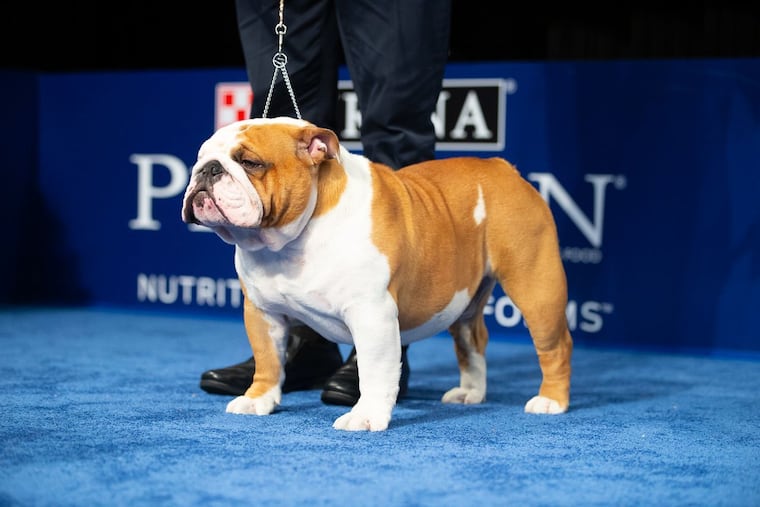Philly’s Dog Show highlighted the English bulldog, but the breed carries a high risk of health woes
Anyone looking to own a bulldog should be aware of possible health risks, and know how to spot an unscrupulous breeder.

A white-and-tan English bulldog named Thor strutted into a championship on Nov. 17, winning Best in Show at the prestigious Kennel Club of Philadelphia’s National Dog Show.
Bulldogs regularly perform well at shows, with their combination of muscular, stocky frame, sour-mug face, and sweet disposition. That can make them popular as pets, too, and breeders say the dogs are ideal companions.
“They’re actually great pets,” said Dorothy Prager, who has been breeding English bulldogs in Zionsville, Lehigh County, since 1975. “They play in the mud, they chase toys, they chase each other. They tend to be easygoing and tolerant.”
The dog is currently listed as the fifth most popular breed by the American Kennel Club. But that appeal comes with sometimes serious health issues stemming from a century and a half of breeding. Some scientists say that the dog, just by virtue of its physical structure, is bound to have problems.
» READ MORE: ‘Thor,’ bulldog owned by Philly-area native, is winner of National Dog Show in Philadelphia
Those who love the animals say that anyone looking to buy a bulldog should be aware of the negatives, and know how to identify unscrupulous breeders.
“The dogs are expensive and popular, and people want to breed them to make money, and that’s their focus,” said Kara Gordon, Thor’s owner, a former Philadelphia resident now living in Houston. “It’s just, ‘How many puppies can I get and how much money can I make?’ If you’re making money breeding dogs, you’re probably not doing it right.”
The English bulldog’s heritage traces back to the particularly unsavory 17th-century sport of bull-baiting. The rules were simple and awful. Chain a bull down, and have a dog clamp onto its head. The winning dog was the one that held on the longest as the bull attempted to thrash itself free. The sport was banned in Britain in 1835.
Dogs were bred for strong jaws, necks, and shoulders, said James Serpell, professor of animal welfare and ethics at the University of Pennsylvania’s School of Veterinary Medicine. Health problems arose when breeders began valuing such qualities as a strong overbite and a brachycephalic, or severely short-nosed, face.
“Mid-19th-century, middle-class hobbyists got a hold of the dog,” he said. “The form of the dog, its appearance, got detached from its function.”
While inbreeding is a culprit, Serpell said, "really the problem is the breed standard, the written description of what the breed should look like. If you follow that standard, you end up with an animal that’s inherently unhealthy.”
The short snouts, combined with other characteristics like large tongues and wide palates, cause breathing problems, according to a 2016 report on the breed’s genetic pool by Niels Pedersen of the University of California, Davis. Many dogs require surgery on their airways. Breathing difficulties can also cause heart problems, as bulldogs have trouble getting enough oxygen into their bloodstream. The dogs’ heads are so large that about 90% of them must be born by cesarean section. Their eyes can be prone to infections, the shape of their tails can cause spinal problems, and their jaws can develop dental problems, Serpell said.
The UC Davis study found there may not be enough genetic diversity within the breed to correct the frequency of physical problems that result from the dog’s structure.
“A DNA-based assessment of the breed along a number of parameters has confirmed that the breed is greatly lacking in genetic diversity,” Pedersen’s report concluded, “which may preclude or minimize the ability of breeders to re-create healthier phenotypes from existing genetic stock.”
The Bulldog Club of America has taken issue with Pedersen’s methodology, and stated his study did not include a wide-enough sample pool to support his conclusions — although Serpell contends that anyone experienced with bulldogs knows they are prone to health problems. Responsible breeders, according to a statement from the club, adhere to standards from 1896 that the animal have “great stability, vigor, and strength” and not be disproportionate. The club does not condone traits like excessive nose wrinkles that could hinder breathing.
Gordon, Thor’s owner, said a purebred bulldog should cost between $2,500 to $3,500. If an animal is significantly cheaper than that, she said, the seller likely is not breeding dogs responsibly.
“When you’re buying one, you get what you pay for sometimes,” she said.
Responsible breeders are registered with the American Kennel Club, she said, adding that dogs should be subject to health tests, and breeders should make their dogs’ health profiles public on the Orthopedic Foundation for Animals’ web site.
Thor, at 2½ years old and about 60 pounds, keeps a busy show schedule, Gordon said, competing in up to three a month. He beat more than 2,000 other dogs in Philadelphia, and has shows in Orlando and Dallas before the end of the year. He is expected to compete in the Westminster Kennel Club Dog Show at Madison Square Garden in New York City in February. Gordon, who once worked with rescue dogs, said not all her bulldogs are natural performers like Thor, and she doesn’t force into competition those who don’t take to it.
“Even when you walk him to the mailbox,” she said of Thor, “he walks the same way as when he’s in the show.”
Thor isn’t the only bulldog living with her, Gordon said. She has three of his puppies, as well, and their mother.
“In terms of him siring other puppies, we’re very, very careful who we allow him to do that with,” she said. “He’s a really healthy dog, thank God. The last thing I want is to perpetuate any kind of health issue.”